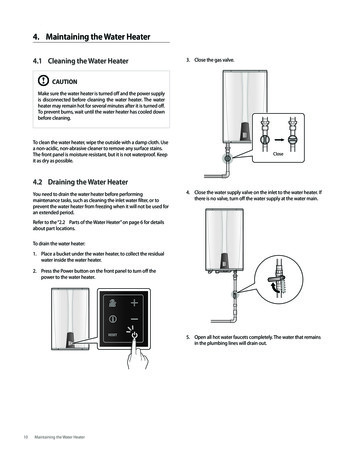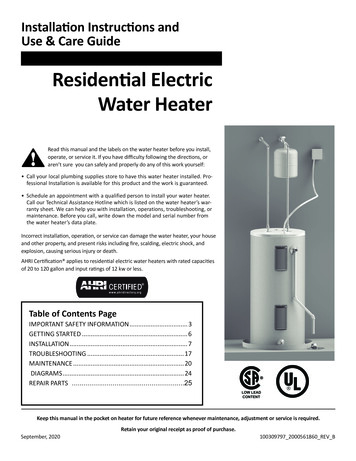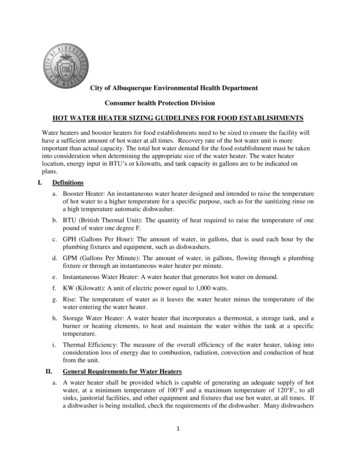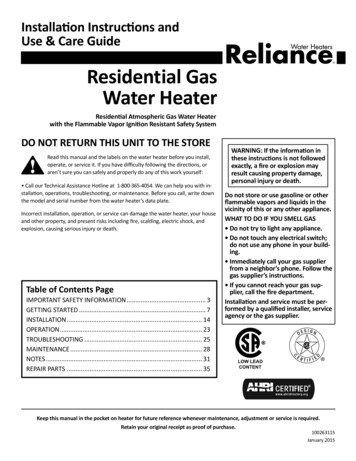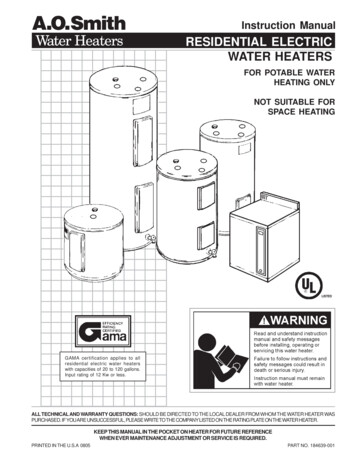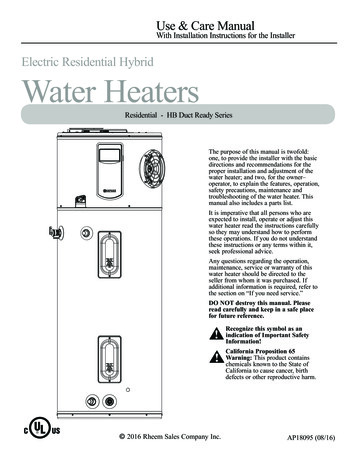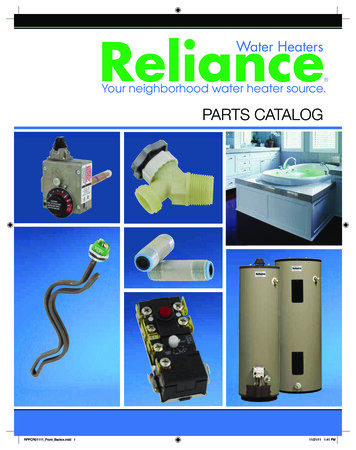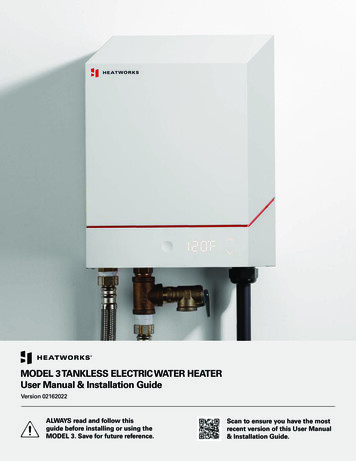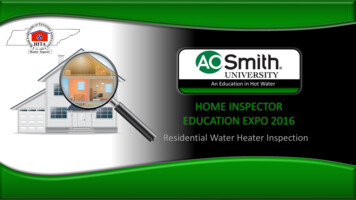
Transcription
An Education in Hot WaterHOME INSPECTOREDUCATION EXPO 2016Residential Water Heater Inspection
Course ObjectiveCourse ObjectiveCompleting this course should enable an inspector toidentify components of gas-fired and electric residential waterheaters; recognize defects and safety hazards in relation tomodern standards and manufacturer requirements; explainhow a flammable vapor ignition resistance system (FVIR)works; recognize the importance of temperature-and-pressurerelief valves and the importance of checking confined spaces.*NOTE* This course in not intended to be a code compliance course. All standards and requirements covered in the course aresuperseded by any and all national, state, and local code enforcement.
Course OutlineCourse Outline Location Requirements Standard Installation Practices Basic Operation Resources
Water Heater Location
Water Heater LocationClosets Gas water heaters should notbe installed in a room used asa storage closet. Closet doors should be oflouvered design.
Water Heater LocationBedroom/Bathroom Gas water heaters should not obtaincombustion air from sleeping rooms,bathrooms or toilet rooms. There aretwo exceptions:1. Installed within a sealed enclosure behind a solid weatherstripped door that prevents the water heater from pullingcombustion air from the living space. The door must be selfclosing.2. The water is of direct vent design.
Water Heater LocationGarages Gas water heaters with an opensource of ignition should be elevatednot less than 18 inches above thegarage floor or be FVIR compliant. The water heater should be installedin such a way that physical damagewould be prevented from anyimpact.
Water Heater LocationAtticsA suitable access opening, passageway, andworkspace is required for attic installations. The access opening should be largeenough to accommodate removal ofthe water heater. The passageway should not be morethat 20’ long, be at least 30” wide,and have continuous flooring at least24” wide. There should be a level workspace atleast 30” wide at the service side ofthe water heater
Water Heater LocationMechanical Rooms Gas water heaters should not beinstalled in a room containing airhandling equipment when that roomis used as a plenum.
Water Heater LocationConfined SpacesA space is defined as “confined” ifthe volume of space in which thewater heater is located is less than50 cubic feet of space per 1,000 Btuof input.(50 cubic feet 2.5ft. X 2.5ft. X 8ft.)
Water Heater Installation
Water Heater InstallationAccessibilityWater heaters should be accessible forroutine inspections, maintenance,adjustments, repairs and replacements. “Accessible” means to reach the waterheater by possibly first removing apanel, door, or similar obstruction thatis part of the water heater. “Accessible” does not mean theremoval of finish materials, such asdrywall, paneling, or built-in cabinets.
Water Heater InstallationLabeling All water heaters are manufactured withlabeling that contain vital informationfor safe and reliable operation. Theselabels must be visible. All water heaters are manufactured witha data plate that indicates the modeland serial number as well as other vitalinformation like fuel type. The waterheaters data plate should always bepresent.
Water Heater InstallationSeismic SupportIn areas that have earthquake risk, it isimportant that a water heater be fastened inplace with straps to avoid damage. Top strapping should be located in theupper one-third and the lower one-thirdof the units vertical dimension. The lower strapping should maintain aminimum distance of 4” above thecontrols. In addition to strapping, approvedflexible connectors should be used.
Water Heater InstallationWater Valves A water valve should be installed in themain cold water supply. The valveshould be located near the water heaterand accessible from the same floor level. The water valve should be of a full-opendesign as to not cause flow restriction.Ball valves are preferred.
Water Heater InstallationFuel Shut-off Valves A fuel shut-off valve for service, repair,and emergency shut-down should beinstalled for all gas water heaters. Fuel lines feeding gas water heatersshould also incorporate a “drip leg” or“dirt leg” to prevent moisture anddebris from entering the control.
Water Heater InstallationElectrical Disconnects An electrical disconnect for service,repair, and emergency shut-downshould be installed for all electric waterheaters. The service wiring that supplies powerto the water heater should be tightlysecured with strain reliefs.The disconnect should be in line of sight of the appliance,or it should be capable of being locked in the open position,and the provision for locking should remain in placewhether locked or unlocked.
Water Heater InstallationVenting requirements UL listed Type B double or single wallmetal vent pipe must be used. Somelocal codes may be more restrictive andnot allow single wall. Single wall pipe may not pass throughattic spaces, crawl spaces, confinedinaccessible locations, or interior walls. Single wall pipe must maintain a 6”clearance from combustible material. Clearances for double wall pipe will bespecified by the manufacturer.
Water Heater InstallationVenting requirements To improve the flow of exhaust gases,we recommend that a minimum of 12”of vertical pipe be installed on the drafthood. Any horizontal runs should not be morethan 75% of the total vertical rise.Horizontal runs should rise by ¼” perfoot. If local codes allow, gas water heatersmay terminate into an existing chimney.Otherwise, it must terminate vertically.
Water Heater Installation
Water Heater InstallationOrphaned water heaters
Water Heater InstallationTemperature and Pressure(T&P) relief valves In order to accurately sense the watertemperature, the T&P valve must belocated in the upper 6” of the waterheater. The T&P valve should be visually andmanually inspected to insure properoperation.
Water Heater InstallationT&P discharge pipes The pipe should be constructed of materialstested, rated, and approved for such use. The pipe should not be directly connected tothe draining system. The pipe should discharge through an air gaplocated in the same room as the water heater. The pipe should not be smaller than thediameter of the outlet valve it serves. The pipe should not have valves or tee fittingsinstalled. The pipe should not have a threaded end. The pipe should serve one outlet valve only.
Water Heater InstallationT&P discharge pipes The pipe should discharge to a positive drain. The pipe should not terminate more than 6”from the floor or drain. The pipe should discharge in a manner thatdoes not cause personal injury or structuraldamage. The pipe should be installed as to flow bygravity. The pipe should discharge to a terminationpoint that is readily observable by thebuilding occupants. The pipe should not be trapped.
Water Heater Installation
Water Heater InstallationSacrificial Anode Rod The anode rod is a sacrificial metal rod thathelps avoid corrosion and premature failure.The anode rod is a consumable item and willneed to be replaced periodically. If the homehas a water softener, the anode will depletefaster than normal.
Water Heater InstallationDrain Pan The water heater should be installed in adrain pan when if it is located in an areawhere a leak would cause structural orproperty damage. The drain pan should not be less than 1.5”deep. A good rule of thumb on size is at least 2”larger than the diameter of the tank.
Water Heater InstallationDrain Valve All water heaters should have a drain valveinstalled for service, maintenance, sedimentremoval, repair, and replacement. We recommend flushing the water heaterthrough the drain valve annually to removesediment.
Water Heater InstallationThermal Expansion Tanks All “closed” plumbing systems requires athermal expansion control device such as athermal expansion tank. Water expands when it is heated. Since thewater is unable to expand back into themunicipal system, the thermal expansion tankwill absorb the expansion.
Water Heater InstallationFuel Conversions Fuel conversions are only allowed whenconverting from LP gas (propane) to naturalgas. The conversion of a gas water heaterfrom natural gas to propane is NOT allowed. The current fuel being used should match thefuel designation on the water heater’s dataplate.
Water Heater InstallationDefects Check for physical damage to the waterheater particularly rust and corrosion on thebottom of the water heater. Check for watermarks on the floor. The inspection coversshould not be disturbed. Check for scorchingaround the burner door. The outer doorshould be in place.
Water Heater Operation
Water Heater OperationTemperature regulation The magic number is 120. According the ASSE 1070, the water heatershould not be the sole device for temperaturecontrol.
Water Heater OperationWater Pressure Most local codes dictate a maximum waterpressure of 80 psi for residences. For water pressure above 80 psi, a PressureReducing Valve (PRV) should be installed. To help avoid premature failure, werecommend an operating pressure of 50 – 60psi.
Water Heater OperationFlammable Vapor IgnitionResistant (FVIR) In 2003, a new standard for water heaterswas developed that states “the water heatershould NOT ignite flammable vapors outsidethe water heater created by the spilling ofgasoline onto the floor.” FVIR compliant water heaters typically havethree components in common: A Lint, Dust, Oil (LDO) screen A flame arrestor plate A thermal cut-off switch
Water Heater OperationBurner Flame The burner flame should be clear blue withslightly yellow tips. The burner flame should not appear to beerratic, “searching” or “rolling out.” The presence of soot would also be anindication of a lack of make-up air.
Water Heater OperationProper Draft Test You will need something to generate smokesuch as a candle, cigar, or cigarette anythingthat will produce smoke. Close all building doors and windows and alldoors between the water heater location andother portions of the building. Also, closefireplace dampers. Turn on all air-moving appliances, such asclothes dryers, kitchen and bathroom exhaustfans, range hoods, and the heating furnace.Also, make sure that any other gas-burningappliance is operating.
Water Heater OperationProper Draft Test Next, open a hot water faucet so that theburner will fire continuously. After the unit has been firing for approximately5 minutes place the source of smoke close tothe opening of the draft hood. The smokeshould be pulled into and up the draft hoodand not float around the draft hood. If the smoke does not continue to be pulledup the draft hood into the vent or blows backinto the room, you have a venting problemthat needs immediate attention.
Water Heater OperationLeaks If you see small puddles of water in the drain pan orhear sizzling sounds as water drips on the burner, thewater heater may be producing condensation. If there is water on the floor around the bottom ofthe water heater, check the plumbing connections ontop of the water heater. Use a dry paper towel towipe around the hot and cold pipe connections ontop of the water heater. If the hot and cold water connections are not leaking,check the T&P relief valve discharge pipe. In mostcases, drips from your water heater’s T&P relief valvedischarge pipe mean the home’s water pressure istoo high or the home’s thermal expansion tank hasfailed
Resources
Recourses
RecoursesWater Heater InspectionChecklist
An Education in Hot WaterTHANK YOUJason Leonard – A.O. Smith
the water heater, check the plumbing connections on top of the water heater. Use a dry paper towel to wipe around the hot and cold pipe connections on top of the water heater. If the hot and cold water connections are not leaking, check the T&P relief valve discharge pipe. In most cases, drips from your water heater's T&P relief valve
